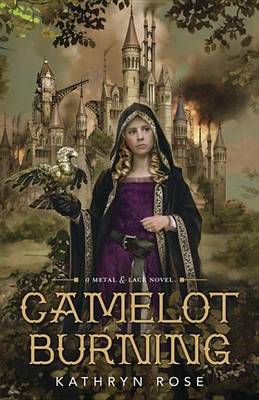Reviewed by Rinn on
What’s not to like about an Arthurian steampunk novel? I was instantly intrigued by the premise of this story, and it didn’t let me down. I was so engrossed that I read half of the book on the train journey to and from London (three hours total). Weaving various characters of Arthurian legend into an original steampunk-based tale, as well as introducing some new, I thought it worked really well.
There are the familiar figures of legend such as King Arthur himself, Merlin (a bit of a drug-addled hippie, no surprise there), Guinevere, Lancelot and various other Knights of the Round Table. From the description of the knights with their dragon tattoos, leather outfits and bars through their ears, as well as kohl-rimmed eyes, I was constantly imagining them as bikers! Somehow this fit in pretty well with the steam and metal filled version of Camelot.
Vivienne, the main character, managed to fit into two sides of society: high society, as the queen’s handmaid, and a secret life as apprentice to Merlin. She was passionate about this secret side of her life, clever and inquisitive, and I just wanted her to completely step away from the court with its dresses and curtsies, embrace something that she obviously loved doing, and screw the consequences. She didn’t mope, she didn’t constantly fawn over her love interest and she just got things done. Talking of the romance, it was a blossoming interest, rather than insta-love (yay!), so much more enjoyable to watch develop – although it would be nice to learn a little more about Marcus.
Vivienne’s family were present but negligible – her parents a lord and lady, her brother a squire – and there is a nice twist in the story about three quarters of the way through that would have really benefited from knowing her family better. As it was, it just wasn’t shocking because I didn’t know anything about the family member in question.
One of my main issues with the book was the world building. Apart from Camelot and its immediate surroundings, the reader wasn’t really told much about the outside world. Jerusalem was mentioned, as was Lyonesse – but world felt so small. As as a result, Morgan le Fay’s threat didn’t seem too great, seeing as the whole ‘world’ pretty much just encompassed the castle of Camelot – how many people would it really affect if she took over? Another problem was magic – or more specifically, why magic was taboo. This wasn’t explained anywhere, so I never really got a sense of just how much danger Merlin or Vivienne were putting themselves in by practising. All I understood is that it was suddenly banned, not why or how, or even when. Magic could also be stolen, which was another thing that wasn’t explained.
A highly enjoyable take on Arthurian legend, recommended for steampunk fans or anyone interested in retellings/alternate tellings of mythology. Despite the lack of world-building, it has a fast-paced and thrilling conclusion, some great steampunk inventions and a clever interpretation of the mythology – the Metal & Lace series is definitely one I’ll be continuing.
Reading updates
- Started reading
- 13 July, 2014: Finished reading
- 13 July, 2014: Reviewed
